In Memoriam: Professor Paul Thomas
This past weekend, Facebook brought me the very sad news that floriculture professor Paul Thomas of the University of Georgia had passed away suddenly on Saturday, September 14. He was 65. At UGA, Paul taught greenhouse management, horticultural business practices and interiorscaping classes. He also served as the State Extension Specialist in floriculture.

Even sadder than Paul’s untimely death is the fact that he had retired from UGA just two weeks ago and had taken a new job with the American Floral Endowment (AFE) to promote their internship programs. At the time of his death, he was in Delaware doing what he loved most: visiting former students and greenhouses.
Wrote Professor Marc van Iersel of UGA in a letter to Paul's friends and colleagues, “Paul was a fierce advocate for his students and placed many of them in greenhouses around the country. He was extremely passionate about working with students and made a tremendous impact on the floriculture industry. We will all miss him, but no one will miss him more than his wife, Toni, and his two sons, the youngest of whom just got married.”
Debi Chedester, executive director of AFE, wrote that Paul had been engaged by them to help out with promoting AFE’s Vic & Margaret Ball Internship program and AFE’s scholarships:
“Paul has been a great supporter of AFE’s programs for many years and has sent dozens of students through AFE’s programs. He helped create the current internship videos we use today that encourage participation by students and the industry.
“Paul volunteered to serve as an AFE Ambassador and had a half dozen visits scheduled between now and the end of the year to talk with other faculty members and speak in front of hort clubs on the east coast. He was such a great educator and had a passion for this industry that was infectious. He loved AFE and spent his entire career promoting the floral industry. He was an amazing person and his presence will be missed by so many.”
The University of Georgia Horticulture Department has set up a scholarship in Paul'a name, with donations going to providing scholarships to students interested in a career in floriculture. Click HERE for more.

Paul on Facebook
Like many in the industry, I was Facebook friends with Paul, and I couldn’t help but note that his posts were almost always about his students—“Hort Dawgs” he called them—and their recent successes in the industry, new jobs and such. Like Matt McCarty, who had been hired on at Green Circle Growers; Emily Currens, the new full-time grower at Brushwood Nursery; and Jeffrey Arner, who landed a job with Copiana, a hydroponic systems company.
Here’s his very last post, dated Thursday, September 12. I think Paul would be pleased with me sharing this, as it wasn’t about him, it was about supporting and celebrating the next generation:
Today I had the pleasure of visiting my last Vic and Margaret Ball program intern. A sad, but also happy, day seeing another successful student doing great things! Sarah Chance is a UGA horticulture major who is interning at North Creek Nursery for six months. North Creek produces quality perennial plugs. The internship is paid and she will receive a $6,000 scholarship when finished. North Creek staff are amazing and they provide an outstanding internship training program. Today was their annual open house. Sarah helped her boss and mentor Gloria with presentations and then gave me a great tour! While there, we bumped into Dr. Bob Lyons who served our industry at VT, UDel, Longwood Gardens and more. Many stories were shared today. 🙂 Sarah has impressed the staff here at North Creek and represents Hort Dawgs perfectly! Many thanks to Steve Castorini (owner) and CEO Tim McGinty for taking such good care of our students! Well done, Sarah! See you back in Georgia in November! And yes … GO HORT DAWGS!
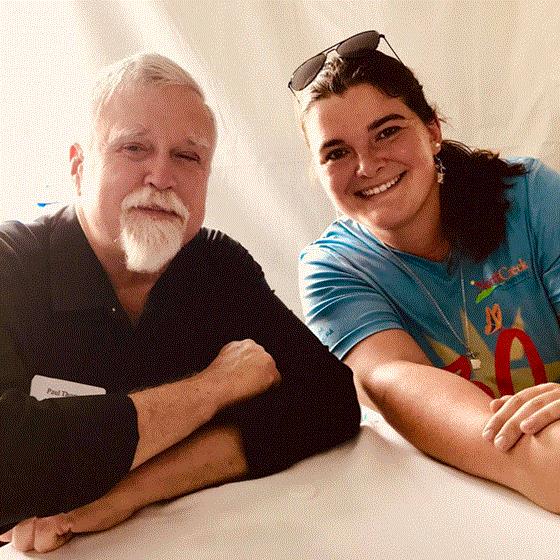

World Hort Summit concludes
I was invited, but I couldn’t quite justify the long trip to Beijing for the World Ornamental Horticulture Summit 2019, hosted by AIPH (the International Association of Horticultural Producers). Sounds like an uber-high-level event, with 300 delegates from 69 countries participating in the three-day event. It was held in conjunction with AIPH's annual meeting and Expo 2019 Beijing, the giant six-month garden show.
What was it about? Mostly, doing business with China. There were three session tracks: Plant Breeding and PBR (plant breeders rights) Protection; Trade and Cooperation with China; and Understanding the Market.
Speakers came from Dümmen Orange, Alibaba Group, the Dutch Flower Group, Sakata Seed, Costa Farms’ Far East Division, Asocoflores in Columbia, the Tanzania Horticulture Association, among others.

What was the take-home? According to AIPH:
- Much work is being done to strengthen Chinese plant breeder rights regulation and enforcement. One speaker expressed the view that China is making significant and fast progress in the area of intellectual property rights.
- At the same time, China is preparing the way for when it will want PBR protection on its varieties as it moves to become a world player in the flower and plant business.
- The speaker from Alibaba, Mr. Lu Zhipeng, manager of their ornamentals and horticultural products sector, emphasized that Chinese consumers today are looking for “unique and high-quality products.”
- Concluded AIPH Secretary General Tim Briercliffe, “There has never been a better time than now to get involved in [the Chinese] market.”

It’s raining bugs (but good bugs!)
And by drone, no less, says editor Jen Zurko. Jen penned the following report on a cool new use for drone technology after a visit to AmericanHort’s Plug & Cutting Conference (of which GrowerTalks/Green Profit is the founding sponsor) in Charlotte, North Carolina:
Something that caught my eye while I was walking through the trade show part of the Plug & Cutting Conference last week was Parabug, a very large drone that spreads biological insects over outdoor crops.
Chandler Bennett was working for a strawberry company in Salinas, California, and, while he was thinking of ways to save on labor costs, he came up with the idea to essentially combine a drone with a bio sachet. The drone flies over the plants while the two rotating drums—which are covered in holes—sprinkle predatory mites like Orius insidiosus. (The drums immediately made me think of a bingo ball machine.) The biologicals and the sawdust they come in are lightweight, so drones are the perfect delivery service for them.
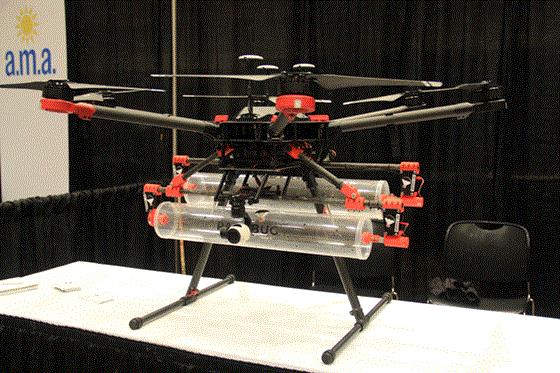
Growers “hire” Parabug to come and disperse bios to their fields, and they can choose whichever beneficial bugs they want and from any vendor (although the Parabug people have a list of vendors they work with if you don’t know any). Jaclyn, Chandler’s wife and business partner, said that it costs about $13 to $17 per acre and Parabug can cover about 500 acres a day. Parabug has only been around for about two years, but in that time they’ve helped fruit and vegetable field growers, tree and shrub nursery growers, and now are just starting in ornamentals. Parabug is way too big to fly around inside a greenhouse, so it’s aimed at outdoor production, such as mums or perennials.
Unfortunately, finicky Chicago weather prevented me from getting to the conference when I wanted, so I missed Parabug’s demonstration during the tour at Metrolina. But you can go to their website (https://www.parabug.solutions) to see a video of it in action.
Oh, and their logo is super clever—a parachuting bug—hence, the name “Parabug.” Get it?

What your patio really wants
Do you long for the good old days of folding aluminum lawn chairs, with the woven plastic fabric that pinches the back of your thighs? Me, neither.
Rest assured, you won’t see anything remotely resembling a Woolworth lawn chair at Casual Market Chicago, an outdoor furnishings show held every year at McCormick Place. I visit it each year, not so much for specific products, but for overall trends—how furniture manufacturers think consumers will want to furnish and decorate their porches and patios next season.
Here are some trends I spotted—including something absolutely shocking that I’ll save for the end:
Mixed materials. An ongoing trend, this is the combining of wood, metal, fabric and ceramics, as well as colors and textures. All-metal or all-wood sets were few and far between.

Hip shapes with traditional materials. As manufacturers mix various materials, they also seem tuned to creating more interesting, modern shapes from traditional materials. Teak gets sleek and woven resin gets less boxy and more curvy or angular, like this set from International Home.

How about these funky chairs from CO9 design. Were they comfortable? I don’t think that’s the point.

Better poly furniture. Furniture made from recycled plastic has always turned me off for its slab-like appearance—like everything is constructed from 1x4s. Boring! But it’s getting better, with more material dimensions, more styles and nicer colors. The Farmhouse Collection from Wildridge features turned legs and a pretty woodgrain-look top.
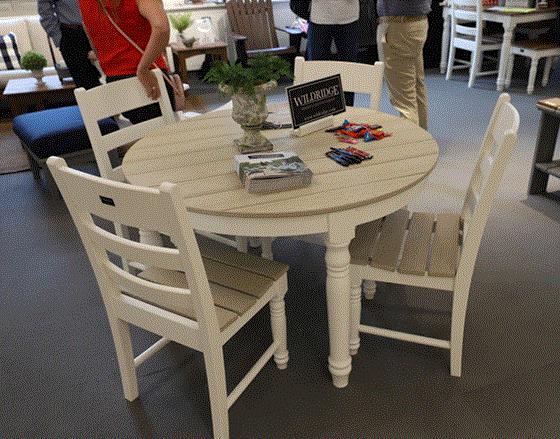
This set from Daybreak (below) could be high-end wood. Note the lack of visible fasteners in both sets, another improvement manufacturers are making.


What I didn't see
Cast aluminum. It’s what’s on my patio, but apparently I’m out of style. I don’t believe I saw a single exhibitor of cast aluminum. Perhaps it’s so ubiquitous, it’s no longer show-worthy—like looking for Coke at a New Beverage trade show.
Traditional teak. I saw a bit, but not much, and nothing in the way of truly traditional shapes, like English garden benches. If I saw such shapes, they were crafted from plastic (like the set from Daybreak, above).
Tropical prints—and not a single monstera leaf! Here’s the shocker: I walked two full aisles before spotting any upholstery sporting a foliage motif—it was this set at Classic Rattan, which had a sort of vintage Hawaiian shirt look:
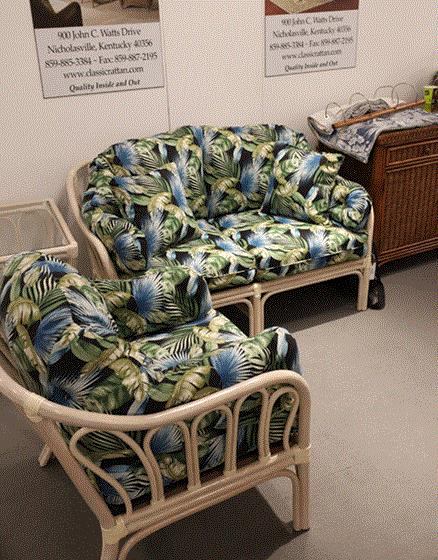
The rest was gray and beige, or perhaps burnt orange. Nary a banana leaf pillow or palm frond cushion or monstera rug. The closest was this, at Jordan Manufacturing:
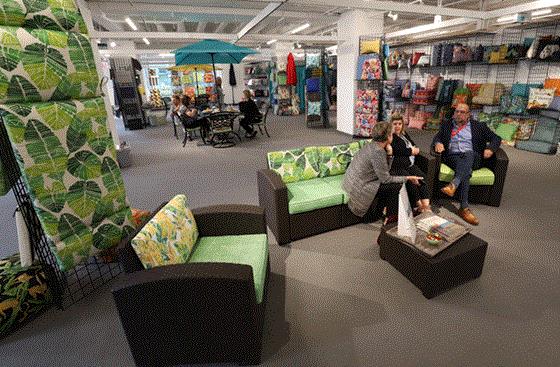
I’m shocked and stunned because when I toured the giant Home and Housewares Show in Chicago back in March, I saw foliage on everything, from serving platters to placemats. One company, which makes lint rollers of all things, used a monstrous monstera leaf as the backdrop to their booth! They seem to know how much consumers like them. And yet at the casual furniture show, the home of porch and patio décor, nada. Odd!
Any of you have a clue why this might be the case? Email me at beytes@growertalks.com.

More on Brexit
The International Garden Centre Association invited Sarah Johnson, a high-level associate from British retailer John Lewis & Partners, to speak one morning. John Lewis, which was founded back in 1864, operates high-end department stores under that name; they also own the Waitrose grocery chain.
During the Q&A, I brought up Brexit and asked if the company could plan for it.
“That is the million-dollar question,” Sarah answered, adding that their corporate affairs team has basically moved into Parliament. But “I’m not sure anything can influence Brexit,” she admitted.
“We have planned for a hard exit. We have stockpiles where we can. But especially in the fresh market, if we have order problems—which I fully expect will happen—our fresh produce is going to be affected because shelf life will be compromised if the lorries are queued up on the M20 or the other side of the Chunnel trying to get over. And I suspect with plants and flowers in the UK, that’s going to be a similar problem. I mean, truly, every day you watch the news and it just gets more bizarre.”
I then asked what she would advise the garden center owners in the room to do.
“Hunker down. I think this is truly out of our hands. You can only prepare as far as possible with non-perishable goods, bringing in what you can if you’ve got stockroom space …
“I think there will be shortages. But to be honest, if Brexit is as difficult as we think, then the last thing people are going to be thinking about is buying stuff from department stores or potentially stuff from garden centers because that discretionary spend may well be diverted. So we’re pinning our hopes on this Christmas and keeping our fingers crossed. I’m not sure we can do much else.
“I’m sorry, that’s really depressing. But it’s just the most bizarre situation.”

Where’s the next IGCA tour?
Speaking of IGCA, I forgot to tell you last time where the 2020 IGCA tour will be held: South Africa! It should be amazing, as the itinerary includes both Johannesburg and Cape Town, with gardens, wineries and who-knows-what-else thrown in for fun in between the garden centers.

Which are world-class, by the way. Quite a few of the South African garden center owners are long-time IGCA travelers, including young Nick Stodel, who even served as the group’s president a few terms back. I’ve been to his place, and it’s awesome, and now he’s got several more that we’ll visit. Plus, the exchange rate is great, so you’ll get a lot for your money—maybe add on a safari!
Mark your calendar for October 18-23, 2020. And head to igca2020.co.za to check out the itinerary and accommodations.
Finally ...
What do you do on a back road on a rainy day?
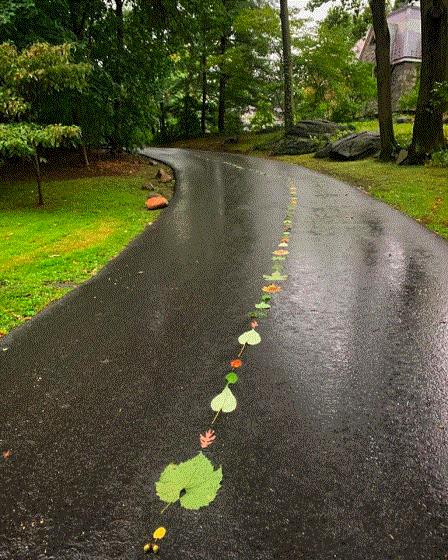
(Shared by Sid Raisch with the IGCs, Suppliers and Media Facebook group.)
See you next time,

Chris Beytes
Editor
GrowerTalks and Green Profit
This e-mail received by 23,841 loyal readers!
Thanks to my loyal sponsors, who help me reach the 23,841 readers of Acres Online in 66 countries. Want to be one of them (a sponsor, that is)? Give Paul Black a shout and he'll hook you up.